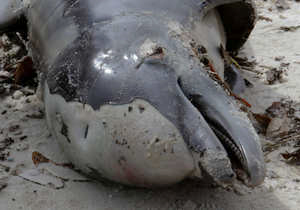New evidence that Corexit dispersant is degrading very slowly while seafloor marine life suffocate covered by oil, dolphin stillborn deaths in January and February 2011 are ten times normal, and many coastal residents are sick.
“The (Corexit) dispersant is sticking around. Key dispersant chemicals
underwent negligible or slow rates of biodegradation.”
- Elizabeth Kujawinski, Ph.D., Marine Chemist,
Woods Hole Oceanographic Institution
“When the world sees something like baby dolphins washing up on shore, it pulls at the heartstrings, and we all want to know why.”
- Blair Mase, Marine Mammal Strandings
Coordinator, SE Region, NOAA

February 23, 2011 Gulfport, Mississippi - Microbiologist Samantha Joye, Ph.D., University of Georgia, showed images of oil-suffocated marine creatures at the bottom of the Gulf of Mexico she photographed in recent research presented before the American Association for the Advancement of Science (AAAS) annual conference in Washington February 14 - 18, 2011. A year ago on April 20, 2010, the BP Macondo oil well erupted nearly a mile down on the Gulf seafloor. Between that day and late July 2010, 206,000,000 gallons of crude oil gushed uncontrollably into the Gulf of Mexico, while 770,000 gallons of Corexit were pumped and sprayed into the Gulf to “disperse” BP's oil disaster.
Click here to subscribe and get instant access to read this report.
Click here to check your existing subscription status.
Existing members, login below:
© 1998 - 2025 by Linda Moulton Howe.
All Rights Reserved.

